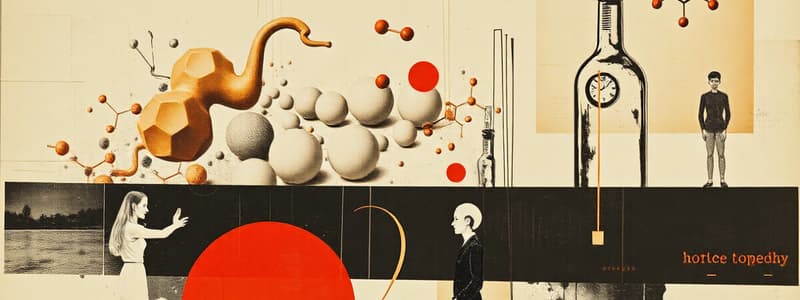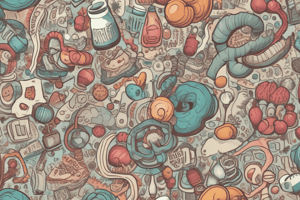Podcast
Questions and Answers
Monosaccharides like glucose and fructose can exist in cyclic forms due to an internal reaction between the carbonyl group and a ______ group.
Monosaccharides like glucose and fructose can exist in cyclic forms due to an internal reaction between the carbonyl group and a ______ group.
hydroxyl
Disaccharides consist of two monosaccharides linked by a ______ bond.
Disaccharides consist of two monosaccharides linked by a ______ bond.
glycosidic
Starch is primarily composed of unbranched ______ and branched amylopectin.
Starch is primarily composed of unbranched ______ and branched amylopectin.
amylose
Cellulose is a major component of plant cell walls, composed of β(1→4) linked ______ units.
Cellulose is a major component of plant cell walls, composed of β(1→4) linked ______ units.
Glycoproteins are proteins covalently attached to short carbohydrate chains called ______.
Glycoproteins are proteins covalently attached to short carbohydrate chains called ______.
A reaction with positive ΔH absorbs heat and is ______.
A reaction with positive ΔH absorbs heat and is ______.
ATP is the primary energy carrier in the ______.
ATP is the primary energy carrier in the ______.
Redox reactions involve the transfer of ______.
Redox reactions involve the transfer of ______.
Glucose-1-phosphate is converted to glucose-6-phosphate by ______.
Glucose-1-phosphate is converted to glucose-6-phosphate by ______.
An increase in ______ favors the spontaneity of a reaction.
An increase in ______ favors the spontaneity of a reaction.
In the liver, glucose-6-phosphatase converts glucose-6-phosphate to free ______.
In the liver, glucose-6-phosphatase converts glucose-6-phosphate to free ______.
Ligation reactions use ATP to form ______ between molecules.
Ligation reactions use ATP to form ______ between molecules.
Insulin promotes glycogenesis and inhibits ______.
Insulin promotes glycogenesis and inhibits ______.
Glycogen Storage Disease Type I is caused by a deficiency of ______-phosphatase.
Glycogen Storage Disease Type I is caused by a deficiency of ______-phosphatase.
Exercise intolerance in McArdle Disease is due to a deficiency of muscle glycogen ______.
Exercise intolerance in McArdle Disease is due to a deficiency of muscle glycogen ______.
Study Notes
Monosaccharides in Aqueous Solutions
- Monosaccharides like glucose and fructose form cyclic structures in aqueous solutions.
- Aldoses (like glucose) form hemiacetals, creating a six-membered ring (pyranose form).
- Ketoses (like fructose) form hemiketals, often creating a five-membered ring (furanose form).
- The cyclical structure creates a new asymmetric carbon called the anomeric carbon.
- The hydroxyl group on the anomeric carbon can be in either α (down) or β (up) configuration, creating anomers.
Disaccharides
- Disaccharides consist of two monosaccharides linked by a glycosidic bond.
- Important disaccharides:
- Sucrose (glucose + fructose): Table sugar, linked by an α(1→2) glycosidic bond.
- Lactose (galactose + glucose): Found in milk, linked by a β(1→4) glycosidic bond.
- Maltose (glucose + glucose): A product of starch digestion, linked by an α(1→4) glycosidic bond.
Polysaccharides
- Polysaccharides are long chains of monosaccharides linked by glycosidic bonds.
- They can be classified as homopolysaccharides (one type of monosaccharide) or heteropolysaccharides (more than one type of monosaccharide).
- Storage polysaccharides:
- Starch: The primary storage form of glucose in plants, consisting of amylose (unbranched, α(1→4) glycosidic bonds) and amylopectin (branched, α(1→6) glycosidic bonds).
- Glycogen: The storage form of glucose in animals, similar to amylopectin but more highly branched, allowing rapid mobilization of glucose.
- Structural polysaccharides:
- Cellulose: A major component of plant cell walls, composed of β(1→4) linked glucose units. Humans cannot digest cellulose due to the lack of enzymes that hydrolyze β-glycosidic bonds.
- Chitin: A structural polysaccharide found in the exoskeletons of insects and crustaceans.
Glycoproteins and Proteoglycans
- Glycoproteins are proteins covalently attached to short carbohydrate chains (oligosaccharides).
- Glycoproteins play roles in cell recognition, signaling, and immune response, often found in the cell membrane.
Bioenergetics
- Entropy (S): Represents the disorder or randomness of a system. Systems naturally tend toward higher entropy.
- Standard Free Energy Change (ΔG⁰'): Measured under specific conditions (1 M concentration of reactants/products, pH 7, 25°C, and 1 atm pressure). It provides a reference point to compare the energy changes of different reactions.
- ATP: The primary energy carrier in the cell, storing energy in its high-energy phosphoanhydride bonds.
- Coupled Reactions: Endergonic reactions (ΔG > 0) can proceed by coupling them to exergonic reactions (ΔG < 0), such as the hydrolysis of ATP.
Types of Biochemical Reactions
- Oxidation-Reduction (Redox) Reactions: Involve the transfer of electrons, often seen in cellular respiration.
- Ligation Reactions: Use ATP to form bonds between molecules, like the synthesis of oxaloacetate.
- Isomerization Reactions: Involve the rearrangement of atoms within a molecule, like the conversion of glucose-6-phosphate to fructose-6-phosphate in glycolysis.
- Group Transfer Reactions: Transfer of a chemical group from one molecule to another, including the conversion of glucose-1-phosphate to glucose-6-phosphate.
Regulation of Glycogen Metabolism
- Hormonal Regulation:
- Insulin: Promotes glycogenesis and inhibits glycogenolysis.
- Glucagon: Stimulates glycogenolysis and inhibits glycogenesis in the liver.
- Epinephrine (Adrenaline): Stimulates glycogenolysis in muscle cells for quick energy during physical activity.
- Allosteric Regulation:
- Glycogen Synthase: Activated by glucose-6-phosphate and inhibited by phosphorylation.
- Glycogen Phosphorylase: Activated by AMP and inhibited by ATP and glucose-6-phosphate.
Glycogen Storage Diseases
- These are genetic disorders resulting from deficiencies in enzymes involved in glycogen metabolism:
- Type I (von Gierke Disease): Deficiency of glucose-6-phosphatase, leading to impaired gluconeogenesis and glycogenolysis, resulting in hypoglycemia and glycogen accumulation in the liver.
- Type II (Pompe Disease): Deficiency of lysosomal α-glucosidase, causing glycogen accumulation in lysosomes, leading to muscle weakness and respiratory problems.
- Type III (Cori Disease): Deficiency of debranching enzyme, resulting in abnormal glycogen with short branches and fasting hypoglycemia.
- Type V (McArdle Disease): Deficiency of muscle glycogen phosphorylase, leading to exercise intolerance due to impaired glycogen breakdown in muscle.
Clinical Relevance
- Proper glycogen metabolism is essential for maintaining blood glucose levels, especially during fasting or between meals.
Lipids
- Triglycerides (Triacylglycerols): Main form of energy storage in animals and plants, stored in adipose tissue.
- Phospholipids: Major components of cell membranes, forming the lipid bilayer, contributing to membrane fluidity.
- Steroids: Characterized by a structure of four fused carbon rings, including cholesterol, which is a precursor for the synthesis of steroid hormones, bile acids, and vitamin D.
- Glycolipids: Found in cell membranes, playing roles in cell recognition and communication.
- Waxes: Provide protective barriers in plants and animals (plant cuticles and earwax).
- Sphingolipids: Involved in signaling and cell recognition, especially in nerve cells and the immune system.
Functions of Lipids
- Energy Storage: Triglycerides serve as a long-term energy reserve.
- Structural Components: Phospholipids and cholesterol are integral to cell membrane structure and function.
- Signaling Molecules: Steroid hormones and other lipids act as signalling molecules to regulate various physiological processes.
- Insulation and Protection: Lipids provide thermal insulation and cushioning for organs.
Dietary Lipids
- Include triglycerides, phospholipids, and cholesterol, which are essential for energy, cell membrane structure, and hormone synthesis.
Nitrogen Metabolism
- Urea Cycle: A metabolic pathway that removes ammonia (NH3) from the body, converting it into urea for excretion.
- Key enzymes in the urea cycle include carbamoyl phosphate synthetase I, ornithine transcarbamylase, and arginase.
- Common examples of urea cycle disorders include: ornithine transcarbamylase deficiency and carbamoyl phosphate synthetase I deficiency.
- Treatment: Reducing protein intake, using medications to help remove excess ammonia, and in some cases, supplementing with compounds that bypass defective steps in the cycle.
Amino Acids: Degradation and Synthesis
- Essential vs. Nonessential Amino Acids: Essential amino acids must be obtained from the diet, while nonessential amino acids are synthesized in the body.
- Some amino acids are conditionally essential, needed from the diet during periods of stress or growth.
- Glucogenic vs. Ketogenic: Amino acids are classified based on their breakdown products:
- Glucogenic Amino Acids: Degraded into pyruvate or citric acid cycle intermediates, which can be converted into glucose via gluconeogenesis.
- Ketogenic Amino Acids: Broken down into acetyl-CoA or acetoacetate, which are precursors for ketone bodies.
- Some amino acids are both glucogenic and ketogenic.
Key Pathways in Amino Acid Catabolism
- Transamination and Deamination: These reactions remove the amino group from amino acids, resulting in α-keto acids that can enter various metabolic pathways.
- Degradation of Specific Amino Acids:
- Aromatic Amino Acids (Phenylalanine and Tyrosine): Phenylalanine is converted to tyrosine, which can further degrade into fumarate and acetoacetate. This pathway is significant because defects lead to disorders like phenylketonuria (PKU).
- Branched-Chain Amino Acids (Valine, Leucine, and Isoleucine): These are primarily broken down in muscle tissues. Valine and isoleucine are glucogenic, while leucine is purely ketogenic.
- Methionine and Homocysteine Metabolism: Methionine serves as a methyl group donor through S-adenosylmethionine (SAM). It converts into homocysteine, which can either be remethylated to methionine or converted to cysteine. Imbalances can increase cardiovascular disease risk.
Amino Acid Synthesis
- Nonessential Amino Acids: Synthesized in the body using intermediates from glycolysis or the citric acid cycle.
Studying That Suits You
Use AI to generate personalized quizzes and flashcards to suit your learning preferences.
Related Documents
Description
Explore the fascinating world of carbohydrates, focusing on their various forms from monosaccharides like glucose and fructose to disaccharides such as sucrose and lactose, and finally, to complex polysaccharides. This quiz covers the structural properties, glycosidic bonds, and configurations of these essential biomolecules in aqueous solutions.




